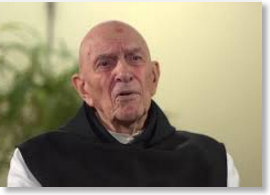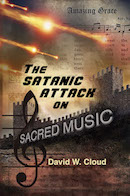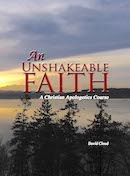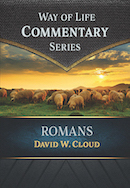866-295-4143, fbns@wayoflife.org
_______________
Centering Prayer
By David Cloud
Centering prayer involves emptying the mind of conscious thoughts about God with the objective of entering into a non-verbal experiential union with God in the center of one’s being.

Here is how he describes it:
“Then we move in faith to God, Father, Son, and Holy Spirit, dwelling in creative love in the depths of our being. This is the whole essence of the prayer. ... All the rest of the method is simply a means to enable us to abide quietly in this center, and to allow our whole being to share in this refreshing contact with its Source” (Finding Grace at the Center, 2002, p. 32).
“... savor the silence, the Presence...” (p. 35).
“As soon as we move in love to God present in our depths, we are there ... we simply want to remain there and be what we are” (p. 39).
“We might think of it as if the Lord Himself, present in our depths, were quietly repeating His own name, evoking His presence and very gently summoning us to an attentive response. We are quite passive. We let it happen” (p. 39).
“... to enter into our Christ-being in the depths” (p. 42).
“... we want immediate contact with God Himself, and not some thought, image, or vision of him...” (p. 42).
“... open yourself interiorly to the mystery of God’s enveloping presence” (p. 48).
“... our theme is the center, that is, the place of meeting of the human spirit and the divine Spirit” (p. 80).
The practice is called “this union” (p. 15), this “face-to-face encounter” (p. 15), “passive meditation” (p. 20), “a fourth state of consciousness” (p. 34), “savoring the silence” (p. 35), “this nothing” (p. 49), “the deep waters of silence” (p. 52), “deep tranquility” (p. 54).
Centering prayer requires entering into a non-thinking mode. The 14th century book The Cloud of Unknowing, which is quoted extensively in the contemplative movement, describes this at length. The very title refers to the practice of entering a mystical state beyond knowledge. It is called “the blind experience of contemplative love,” “this darkness,” “this nothingness,” “this nowhere.”
Note the following statements:
“Do all in your power to FORGET EVERYTHING ELSE, keeping your thoughts and desires free from involvement with any of God’s creatures or their affairs whether in general or in particular ... pay no attention to them” (The Cloud of Unknowing, edited by William Johnston, Image Books, 1973, chapter 3, p. 48).
“Thought cannot comprehend God. And so, I prefer to abandon all I can know, choosing rather to love him whom I cannot know. ... By love he may be touched and embraced, NEVER BY THOUGHT. ... in the real contemplative work you must set all this aside and cover it over with a cloud of forgetting” (chapter 6, pp. 54, 55).
“... DISMISS EVERY CLEVER OR SUBTLE THOUGHT no matter how holy or valuable. Cover it over with a thick cloud of forgetting because in this life only love can touch God as he is in himself, never knowledge” (chapter 8, pp. 59, 60).
“So then, you must reject all clear conceptualizations whenever they arise, as they inevitably will, during the blind work of contemplative love. ... Therefore, FIRMLY REJECT ALL CLEAR IDEAS, however pious or delightful” (chapter 9, p. 60).
The Book of Privy Counseling, written by the author of The Cloud of Unknowing, says:
“REJECT ALL THOUGHTS, BE THEY GOOD OR BE THEY EVIL” (The Cloud of Unknowing and The Book of Privy Counseling, edited by William Johnston, Image Books, 1973, chapter 1, p. 149).
A MANTRA is the key to entering the non-thinking mode. The practitioner is taught to choose “a sacred word” such as love or God and repeat it until the mind is emptied and carried away into a non-thinking communion with God at the center of one’s being.
“... the little word is used in order to sweep all images and thoughts from the mind, leaving it free to love with the blind stirring that stretches out toward God” (William Johnston, The Cloud of Unknowing, introduction, p. 10).
The practitioner is taught that he must not think on the meaning of the word.
“... choose a short word ... a one-syllable word such as ‘God’ or ‘love’ is best. ... Then fix it in your mind so that it will be your defense in conflict and in peace. Use it to beat upon the cloud of darkness above you and to subdue all distractions, consigning them to the cloud of forgetting beneath you. ... If your mind begins to intellectualize over the meaning and connotations of this little word, remind yourself that its value lies in its simplicity. Do this and I assure you these thoughts will vanish” (The Cloud of Unknowing, chapter 7, p. 56).
“... focus your attention on a simple word such as sin or God ... and WITHOUT THE INTERVENTION OF ANALYTICAL THOUGHT allow yourself to experience directly the reality it signifies. Do not use clever logic to examine or explain this word to yourself nor allow yourself to ponder its ramifications ... I DO NOT BELIEVE REASONING EVER HELPS IN THE CONTEMPLATIVE WORK. This is why I advise you to leave these words whole, like a lump, as it were” (The Cloud of Unknowing, chapter 36, p. 94).
The attempt to achieve a mindless mystical condition through a mantra can produce a hypnotic state and open one to demonic activity. Even if you don’t consciously try to lose the meaning of the word, it quickly becomes lost to the mind. Ray Yungen, who has done extensive and excellent research into the New Age, explains:
“When a word or phrase is repeated over and over, after just a few repetitions, those words lose their meaning and become just sounds. ... After three or four times, the word can begin to lose its meaning, and if this repeating of words were continued, normal thought processes could be blocked, making it possible to enter an altered state of consciousness because of the hypnotic effect that begins to take place. It really makes no difference whether the words are ‘You are my God’ or ‘I am calm,’ the results are the same” (A Time of Departing, p. 150).
Catholic contemplative master Anthony de Mello agrees. He says:
“A Jesuit friend who loves to dabble in such things ... assures me that, through constantly saying to himself ‘one-two-three-four’ rhythmically, he achieves the same mystical results that his more religious conferees claim to achieve through the devout and rhythmical recitation of some ejaculation. And I believe him” (Sadhana: A Way to God, pp. 33, 34).
Centering prayer is so similar to the mystical practice of pagan religions that they recognize it as their own. In his introduction to his edition of The Cloud of Unknowing, William Johnston says the Catholic author of this 14th century work “speaks a language that Buddhists understand” (p. 11).
Practitioners of eastern religions recognize the power of the mantra in entering the meditative state. Hindu gurus say, “One thorn is removed by another.” They are referring to the fact that since the mind must be occupied with something, one word or thought can be used to drive away all others.
Deepak Chopra, a New Age Hindu who believes in the divinity of man, recommends The Cloud of Unknowing. He considers the Catholic centering prayer techniques to be the same as Hindu yoga.
“There is no doubt that people resist the whole notion of God being an inner phenomenon. ... Yet its importance is stated eloquently in the medieval document known as ‘The Cloud of Unknowing,’ written anonymously in the fourteenth century. ... The writer informs us that ANY THOUGHT IN THE MIND SEPARATES US FROM GOD, because thought sheds light on its object. ... Even though the cloud of unknowing baffles us, it is actually closer to God than even a thought about God and his marvelous creation. We are advised to go into a ‘cloud of forgetting’ about anything other than the silence of the inner world. For centuries this document has seemed utterly mystical, but it makes perfect sense once we realize that the restful awareness response, WHICH CONTAINS NO THOUGHTS, is being advocated. ...
“We aren’t talking about the silence of an empty mind ... But the thought takes place against a background and nonthought. Our writer equates it with KNOWING SOMETHING THAT DOESN’T HAVE TO BE STUDIED. The mind is full of a kind of knowing that could speak to us about anything, yet it has no words; therefore we seek this knowingness in the background” (Chopra, How to Know God, 2000, pp. 94, 95, 98).
This Hindu says that to approach God through a mindless “cloud of unknowing” makes perfect sense, and well it should to him, because that is standard Hindu practice; but this should be a loud warning to those who believe that God has revealed Himself in Jesus Christ and the Bible. It should be a warning that Catholic contemplative prayer is not Christian!
In this same book, Chopra says, “I believe that God has to be known by looking in the mirror” (p. 9). Thus, Chopra is describing meditative methods whereby the individual can allegedly come into contact with his “higher self” or divinity, yet he is using Catholic mysticism to get there!
That the same manual (The Cloud of Unknowing) is also popular with contemplative evangelicals and Southern Baptists and that they teach the same techniques as this New Age Hindu guru is a loud warning to those who have ears to hear.
Richard Foster says, “Christian meditation is an attempt to empty the mind in order to fill it” (Celebration of Discipline, 1978, p. 15). He says, “[W]e must be willing to go down into the recreating silences...” (p. 15). He says the goal of contemplative prayer is “a pure relationship where we see ‘nothing’” (Prayer: Finding the Heart’s True Home, p. 155).
The result of centering prayer is supposed to be mystical knowledge, obtained through communion with God in one’s being.
“For in this darkness we experience an intuitive understanding of everything material and spiritual without giving special attention to anything in particular” (The Cloud of Unknowing, chapter 68, p. 137).
“He will let you glimpse something of the ineffable secrets of his divine wisdom...” (The Cloud of Unknowing, chapter 27, p. 84).
“Often meditation will yield insights ... More than once I have received guidance ... it is far more common to be given guidance in dealing with ordinary human problems ... It tells us that God is speaking in the continuous present and wants to address us” (Richard Foster, Celebration of Discipline, 1978, pp. 17, 19).
“... we learn that our willingness to listen in silence opens up a quiet space in which we can hear His voice, a voice that longs to speak and offer us guidance for our next step” (Ruth Barton, “Beyond Words,” Discipleship Journal, Sept-Oct. 1999).
Contemplative mystics claim that centering prayer is based on the example of Mary in Luke 10:38-42. William Johnson says:
“Mary turned to Jesus with all the love of her heart, unmoved by what she saw or heard spoken and done about her. She sat there in perfect stillness with her heart’s secret, joyous love intent upon that cloud of unknowing between her and her God. ... Jesus is present; he is the divine center to which Mary’s love is directed. But she has no regard for clear cut images of his beautiful mortal body, no ears for the sweetness of his human voice. She has gone beyond all this to a deeper knowledge, a deeper love and a deeper beauty” (pp. 17, 18; see also The Cloud of Unknowing, chapter 17, p. 71).
This is an example of how contemplatives twist the Scripture. In reality, Mary was not practicing mystical contemplation. She did not empty her mind; she was not going beyond words to some sort of deeper knowledge. She simply sat and listened to Christ speak. “And she had a sister called Mary, which also sat at Jesus’ feet, and heard his word” (Luke 10:39). She was not trying to achieve union with God through mystical means. She knew that the Son of God was there in human flesh and that she did not have to know anything beyond Him. To know Christ is to know God! Rather than a “cloud of unknowing,” Mary had perfect revelation in the Person of Christ and in His spoken words, and so do we.
“God, who at sundry times and in divers manners spake in time past unto the fathers by the prophets, Hath in these last days spoken unto us by his Son...” (Hebrews 1:1-2).
“For God, who commanded the light to shine out of darkness, hath shined in our hearts, to give the light of the knowledge of the glory of God in the face of Jesus Christ” (2 Corinthians 4:6).
Centering prayer is actually a blind leap into the dark.
- Receive these reports by email
- www.wayoflife.org
______________________
Sharing Policy: Much of our material is available for free, such as the hundreds of articles at the Way of Life web site. Other items we sell to help fund our expensive literature and foreign church planting ministries. Way of Life's content falls into two categories: sharable and non-sharable. Things that we encourage you to share include the audio sermons, O Timothy magazine, FBIS articles, and the free eVideos and free eBooks. You are welcome to make copies of these at your own expense and share them with friends and family. You may also post parts of reports and/or entire reports to websites, blogs, etc as long as you give proper credit (citation). A link to the original report is very much appreciated as the reports are frequently updated and/or expanded. Things we do not want copied and distributed are "Store" items like the Fundamental Baptist Digital Library, print editions of our books, electronic editions of the books that we sell, the videos that we sell, etc. The items have taken years to produce at enormous expense in time and money, and we use the income from sales to help fund the ministry. We trust that your Christian honesty will preserve the integrity of this policy. "For the scripture saith, Thou shalt not muzzle the ox that treadeth out the corn. And, The labourer is worthy of his reward" (1 Timothy 5:18). Questions? support@wayoflife.org
Goal:Distributed by Way of Life Literature Inc., the Fundamental Baptist Information Service is an e-mail posting for Bible-believing Christians. Established in 1974, Way of Life Literature is a fundamental Baptist preaching and publishing ministry based in Bethel Baptist Church, London, Ontario, of which Wilbert Unger is the founding Pastor. Brother Cloud lives in South Asia where he has been a church planting missionary since 1979. Our primary goal with the FBIS is to provide material to assist preachers in the edification and protection of the churches.
Offering: Offerings are welcome if you care to make one. If you have been helped and/or blessed by our material offerings can be mailed or made online with with Visa, Mastercard, Discover, or Paypal. For information see: www.wayoflife.org/about/makeanoffering.html.





